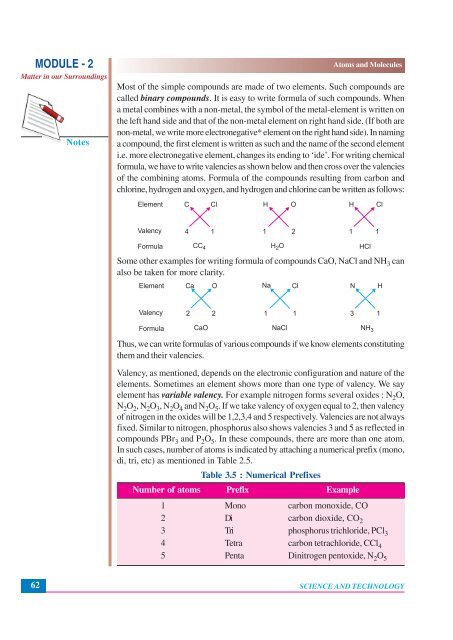You also want an ePaper? Increase the reach of your titles
YUMPU automatically turns print PDFs into web optimized ePapers that Google loves.
MODULE - 2<br />
Matter in our Surroundings<br />
Notes<br />
Atoms and Molecules<br />
Most of the simple compounds are made of two elements. Such compounds are<br />
called binary compounds. It is easy to write formula of such compounds. When<br />
a metal combines with a non-metal, the symbol of the metal-element is written on<br />
the left hand side and that of the non-metal element on right hand side. (If both are<br />
non-metal, we write more electronegative* element on the right hand side). In naming<br />
a compound, the first element is written as such and the name of the second element<br />
i.e. more electronegative element, changes its ending to ‘ide’. For writing chemical<br />
formula, we have to write valencies as shown below and then cross over the valencies<br />
of the combining atoms. Formula of the compounds resulting from carbon and<br />
chlorine, hydrogen and oxygen, and hydrogen and chlorine can be written as follows:<br />
Some other examples for writing formula of compounds CaO, NaCl and NH 3 can<br />
also be taken for more clarity.<br />
Thus, we can write formulas of various compounds if we know elements constituting<br />
them and their valencies.<br />
Valency, as mentioned, depends on the electronic configuration and nature of the<br />
elements. Sometimes an element shows more than one type of valency. We say<br />
element has variable valency. For example nitrogen forms several oxides : N 2 O,<br />
N 2 O 2 , N 2 O 3 , N 2 O 4 and N 2 O 5 . If we take valency of oxygen equal to 2, then valency<br />
of nitrogen in the oxides will be 1,2,3,4 and 5 respectively. Valencies are not always<br />
fixed. Similar to nitrogen, phosphorus also shows valencies 3 and 5 as reflected in<br />
compounds PBr 3 and P 2 O 5 . In these compounds, there are more than one atom.<br />
In such cases, number of atoms is indicated by attaching a numerical prefix (mono,<br />
di, tri, etc) as mentioned in Table 2.5.<br />
Table 3.5 : Numerical Prefixes<br />
Number of atoms Prefix Example<br />
1 Mono carbon monoxide, CO<br />
2 Di carbon dioxide, CO 2<br />
3 Tri phosphorus trichloride, PCl 3<br />
4 Tetra carbon tetrachloride, CCl 4<br />
5 Penta Dinitrogen pentoxide, N 2 O 5<br />
62<br />
SCIENCE <strong>AND</strong> TECHNOLOGY
















